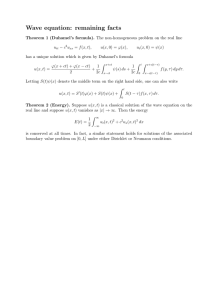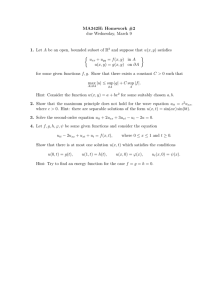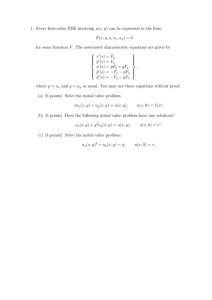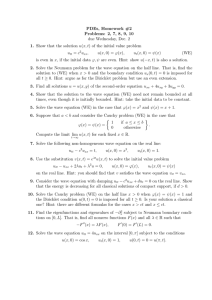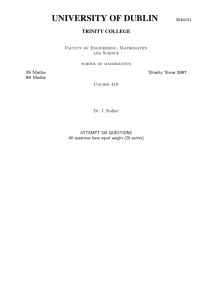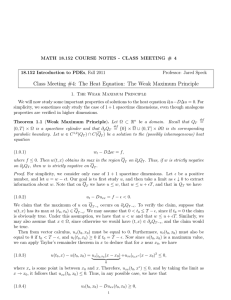Part II. Analysis of PDE Lecture notes for MA342H P. Karageorgis
advertisement
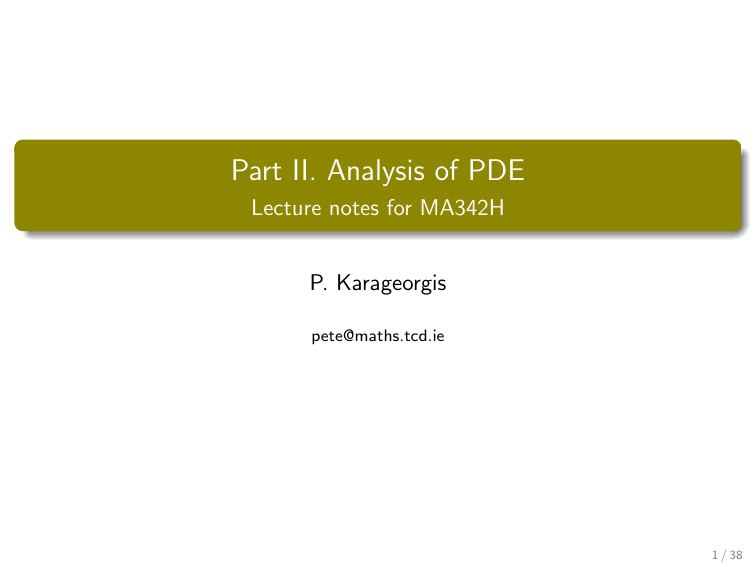
Part II. Analysis of PDE
Lecture notes for MA342H
P. Karageorgis
pete@maths.tcd.ie
1 / 38
Second-order linear equations
Consider the linear operator L(u) which is defined by
L(u) = a1 uxx + a2 uyy + b1 ux + b2 uy
for some constants a1 , a2 , b1 , b2 such that one of a1 , a2 is nonzero.
This operator is called elliptic when a1 a2 > 0, it is called hyperbolic
when a1 a2 < 0, and it is called parabolic when a1 a2 = 0.
The Laplace equation uxx + uyy = 0 is a typical example of an elliptic
equation. The solutions of this equation are usually called harmonic.
The wave equation utt − c2 uxx = 0 is hyperbolic for any c > 0. It is
used to describe the motion of a wave whose speed c is constant.
The heat equation ut − kuxx = 0 is parabolic for any k > 0. In this
case, u(x, t) denotes the temperature of an one-dimensional object.
2 / 38
Maximum principle
Theorem 1. Maximum principle
Consider the second-order linear operator
L(u) = a1 uxx + a2 uyy + b1 ux + b2 uy
in the elliptic case a1 , a2 > 0. Suppose A ⊂ R2 is open and bounded.
1
If L(u) ≥ 0 within A, then maxA∪∂A u = max∂A u.
2
If L(u) ≤ 0 within A, then minA∪∂A u = min∂A u.
Moreover, the same result holds in the parabolic case a1 > 0 = a2 .
The function u attains a min/max over the sets A ∪ ∂A and ∂A
because these sets are closed and bounded, hence also compact.
The second part of the theorem follows trivially from the first.
3 / 38
Maximum principle: Proof of part 1
Define w(x, y) = u(x, y) + δeλx for some δ, λ > 0. Since
L(w) = L(u) + δL(eλx ) = L(u) + δλeλx (a1 λ + b1 ),
one has L(w) > 0 within A for all large enough λ.
If the maximum of w is attained at an interior point, then
L(w) = a1 wxx + a2 wyy + b1 wx + b2 wy = a1 wxx + a2 wyy ≤ 0
at that point and this is a contradiction. In particular, one has
max u ≤ max w = max w = max (u + δeλx ).
A∪∂A
A∪∂A
∂A
∂A
Once we now let δ → 0, we may finally conclude that
max u ≤ max u ≤ max u
A∪∂A
∂A
A∪∂A
=⇒
max u = max u.
A∪∂A
∂A
4 / 38
Extended maximum principle
Theorem 2. Extended maximum principle
Consider the linear operator L(u) in the case that a1 > 0 and a2 ≥ 0.
Suppose A is a bounded, open subset of R2 and suppose c(x, y) is a
function which is continuous on A with c(x, y) ≤ 0 at all points.
1
If L(u) + cu ≥ 0 within A, then maxA∪∂A u ≤ max∂A u+ .
2
If L(u) + cu ≤ 0 within A, then minA∪∂A u ≥ min∂A u− .
3
If L(u) + cu = 0 within A, then maxA∪∂A |u| = max∂A |u|.
Here, u+ denotes the positive part of u, namely u+ = max(u, 0).
Similarly, u− denotes the negative part of u, namely u− = min(u, 0).
This theorem does not necessarily hold when c(x, y) is positive.
5 / 38
Extended maximum principle: Counterexample
We show that the extended maximum principle does not necessarily
hold when the function c(x, y) is positive. Consider the case
uxx + uyy + 2u = 0,
x, y ∈ (0, 2π).
As one can easily check, this equation is satisfied by the function
u(x, y) = (sin x) · (sin y).
Now, the set A = (0, 2π) × (0, 2π) is certainly open and bounded,
while u vanishes on ∂A since either x = 0, 2π or y = 0, 2π on ∂A.
If the extended maximum principle did hold, then one would have
max |u| = max |u| = 0.
A∪∂A
∂A
This is not the case, however, as the left hand side is equal to 1.
6 / 38
Extended maximum principle: Proof of part 1
Let B = {(x, y) ∈ A : u(x, y) > 0}. If this set is empty, then
u ≤ 0 in A
=⇒
=⇒
u ≤ 0 in A ∪ ∂A by continuity
max u ≤ 0 ≤ max u+
A∪∂A
∂A
and the result follows. If B is nonempty, then
L(u) ≥ −cu ≥ 0 in B
=⇒
max u = max u
B∪∂B
∂B
by the standard maximum principle. This actually gives
max u = max u ≤ max u+ = max u+
B∪∂B
∂B
∂B
∂A
and one also has u(x, y) ≤ 0 ≤ max∂A u+ for all (x, y) ∈ A − B.
7 / 38
Extended maximum principle: Proof of part 2
Since L(u) + cu ≤ 0 within A by assumption, one has
−L(u) − cu ≥ 0
=⇒
L(−u) + c(−u) ≥ 0
within A. Using the first part of the theorem, we conclude that
max (−u) ≤ max (−u)+ .
A∪∂A
∂A
Here, the rightmost function can also be expressed as
(−u)+ = max(−u, 0) = − min(u, 0) = −u− .
Thus, one may combine the last two equations to deduce that
max (−u) ≤ max (−u− )
A∪∂A
∂A
=⇒
min u ≥ min u− .
A∪∂A
∂A
8 / 38
Extended maximum principle: Proof of part 3
First of all, it is easy to see that
max |u| = max max u+ , max (−u− ) .
A∪∂A
We now estimate
u+
A∪∂A
and
−u− .
A∪∂A
In view of part 1, one certainly has
u+ (x, y) = max(u(x, y), 0) ≤ max u+
∂A
for all (x, y) ∈ A ∪ ∂A. In view of part 2, one similarly has
−u− (x, y) = − min(u(x, y), 0) ≤ − min u− = max (−u− ).
∂A
∂A
Inserting these estimates in the first equation, we conclude that
max |u| ≤ max max u+ , max (−u− )
A∪∂A
∂A
∂A
= max |u| ≤ max |u|.
∂A
A∪∂A
9 / 38
Uniqueness of solutions
Theorem 3. Uniqueness of solutions
Let L, A, c be as before and suppose f, g are continuous. Then the
following boundary value problem admits at most one solution.
L(u) + cu = f (x, y) in A
.
u = g(x, y) on ∂A
Indeed, assume u, v are solutions and let w = u − v. Since
L(w) + cw = L(u) − L(v) + cu − cv = f − f = 0
within A, the third part of the extended maximum principle gives
max |w| = max |w| = max |g − g| = 0.
A∪∂A
∂A
∂A
In particular, w = 0 at all points and thus u = v at all points.
10 / 38
First comparison principle
Theorem 4. Comparison principle in bounded domains
Let L, A, c be as before and suppose the functions u, v satisfy
L(u) + cu ≤ L(v) + cv in A
.
u(x, y) ≥ v(x, y)
on ∂A
Then one actually has u(x, y) ≥ v(x, y) for all (x, y) ∈ A ∪ ∂A.
To prove this theorem, we note that w = v − u satisfies
L(w) + cw = L(v) − L(u) + cv − cu ≥ 0 within A.
According to the extended maximum principle, this implies that
max (v − u) = max w ≤ max w+ .
A∪∂A
A∪∂A
∂A
Since w+ = max(v − u, 0) = 0 on ∂A, the result now follows.
11 / 38
First comparison principle: Example
Let A = (0, 1) × (0, 1) and consider the boundary value problem
uxx + uyy = −1 in A
.
u(x, y) = 0 on ∂A
Take L(u) = uxx + uyy and let v denote the zero function. Since
L(u) = −1 ≤ 0 = L(v)
within A and u ≥ v on ∂A, we conclude that u ≥ v in A ∪ ∂A. This
proves the lower bound u ≥ 0 for the unknown function u.
To obtain an upper bound, let w = a + b(x2 + y 2 ) and suppose
L(w) ≤ L(u)
⇐⇒
4b ≤ −1.
To ensure that w ≥ u on ∂A, we need to have a ≥ −2b. Once we
now take a = −2b = 1/2, we find that u ≤ w = (2 − x2 − y 2 )/4.
12 / 38
A priori estimates
Theorem 5. A priori estimates
Let A be an open, bounded subset of R2 and suppose u satisfies
L(u) = f in A
.
u = 0 on ∂A
Then there exists a positive constant C such that
max |u| ≤ C · sup |f |.
A∪∂A
A
More generally, suppose that L(u1 ) = f1 and L(u2 ) = f2 in A. If the
functions u1 , u2 are equal on ∂A, then the theorem implies that
max |u1 − u2 | ≤ C · sup |f1 − f2 |.
A∪∂A
A
In particular, the solution of L(u) = f depends continuously on f .
13 / 38
A priori estimates: Proof
We may assume that x0 ≤ x ≤ x1 for all points (x, y) ∈ A. Let
w(x, y) = c(eλx1 − eλx )
for some constants c, λ ≥ 0 to be chosen later and note that
−L(w) = cL(eλx ) = cλ(a1 λ + b1 )eλx ≥ ceλx0
for all large enough λ. Setting c = e−λx0 supA |f |, we now get
−L(w) ≥ sup |f | ≥ |L(u)|
=⇒
−L(w) ≥ L(u) ≥ L(w).
A
Since −w ≤ u ≤ w on ∂A, this implies −w ≤ u ≤ w in A, so
|u(x, y)| ≤ w(x, y) ≤ ceλx1 = eλ(x1 −x0 ) sup |f |.
A
14 / 38
Second comparison principle
Theorem 6. Comparison principle for the heat equation
Let k > 0 and b ∈ R. Suppose that u, v satisfy the equation
ut − kuxx + bux = 0 for all x ∈ [x0 , x1 ] and all t ≥ 0.
If u ≥ v when x = x0 , x1 and when t = 0, then u ≥ v at all points.
This result compares u, v over an unbounded domain. Our previous
comparison principle was only valid over a bounded domain.
It is easy to check that the given equation has separable solutions
u(x, t) = ae−
u(x, t) = ae−
(b2 +4k2 m2 )t
4k
(b2 +4k2 m2 )t
4k
bx
· e 2k sin(mx),
bx
· e 2k cos(mx),
a, m ∈ R,
a, m ∈ R.
15 / 38
Second comparison principle: Proof
Define w(x, y) = v(x, y) − u(x, y) + δeλx for some δ, λ > 0. Since
L(u) = −ut + kuxx − bux
=⇒
L(w) = δλeλx (kλ − b),
it is clear that L(w) > 0 for all large enough λ.
Consider the maximum value of w over the set [x0 , x1 ] × [0, T ]. If it
is attained at either an interior point or a point with t = T , then
wx = 0,
wxx ≤ 0,
wt ≥ 0
at that point and this gives the contradiction L(w) ≤ 0. Thus, the
maximum is attained on the remaining part of the boundary and
(v − u + δeλx ).
v − u ≤ w ≤ x=x
max
,x
0
t=0
1
Once we now let δ → 0, we may finally conclude that
(v − u) ≤ 0 at all points.
v − u ≤ x=x
max
,x
0
t=0
1
16 / 38
Second comparison principle: Example
Consider the boundary value problem for the heat equation
ut − uxx = 0 for all 0 ≤ x ≤ π and t ≥ 0
subject to the boundary and initial conditions
u(0, t) = u(π, t) = 0,
u(x, 0) = f (x).
We assume that there exist constants α ≤ β such that
α sin x ≤ f (x) ≤ β sin x for all 0 ≤ x ≤ π.
In view of this assumption, it is easy to see that the inequality
αe−t sin x ≤ u(x, t) ≤ βe−t sin x
holds when t = 0 and also when x = 0, π. Since all three functions
satisfy the heat equation, the inequality holds for all x, t. It easily
follows that u(x, t) tends to zero as t → ∞.
17 / 38
Wave equation, page 1
To solve the wave equation utt = c2 uxx , we express it in the form
2
2
∂
∂
∂
∂
∂
2 ∂
−
c
+
c
−
c
u
=
0
=⇒
u = 0.
∂t2
∂x2
∂t
∂x
∂t
∂x
This factorisation suggests the use of variables α, β such that
∂
∂
∂
=
+c
,
∂α
∂t
∂x
∂
∂
∂
=
−c
.
∂β
∂t
∂x
Using these new variables, one may now integrate twice to get
∂ ∂
u=0
∂α ∂β
=⇒
=⇒
∂
u = f (β)
∂β
Z
u = f (β) dβ + G(α) = F (β) + G(α)
for some functions F, G. Thus, it remains to determine α and β.
18 / 38
Wave equation, page 2
Based on our computation above, the variables α, β should satisfy
∂
∂
∂
=
+c
,
∂α
∂t
∂x
∂
∂
∂
=
−c
.
∂β
∂t
∂x
According to the chain rule, however, they must also satisfy
∂
∂t ∂
∂x ∂
=
+
,
∂α
∂α ∂t ∂α ∂x
∂
∂t ∂
∂x ∂
=
+
.
∂β
∂β ∂t ∂β ∂x
This gives tα = 1 = tβ and xα = c = −xβ , so one may take
t = α + β,
x = cα − cβ.
In particular, the variables α, β that we seek may be defined as
α=
ct + x
,
2c
β=
ct − x
.
2c
19 / 38
D’Alembert’s formula
Theorem 7. General solution
Consider the wave equation utt − c2 uxx = 0, where c > 0 is a fixed
constant. Every solution of this equation must have the form
u(x, t) = F (x − ct) + G(x + ct).
Theorem 8. D’Alembert’s formula
Consider the wave equation utt − c2 uxx = 0, where c > 0 is a fixed
constant. There is a unique solution that satisfies u(x, 0) = ϕ(x) and
also ut (x, 0) = ψ(x) for all x ∈ R. In fact, this unique solution is
ϕ(x − ct) + ϕ(x + ct)
1
u(x, t) =
+
2
2c
Z
x+ct
ψ(s) ds.
x−ct
20 / 38
D’Alembert’s formula: Proof
Every solution of the wave equation must have the form
u(x, t) = F (x − ct) + G(x + ct),
ut (x, t) = −cF ′ (x − ct) + cG′ (x + ct).
To ensure that the initial conditions hold, we must also have
ϕ(x) = F (x) + G(x),
ψ(x) = −cF ′ (x) + cG′ (x).
Eliminating F ′ (x) gives cϕ′ (x) + ψ(x) = 2cG′ (x), hence also
Z
1 x
ϕ(x)
ψ(s) ds + d1 ,
+
G(x) =
2
2c 0
Z
ϕ(x)
1 0
F (x) =
ψ(s) ds − d1 .
+
2
2c x
Since u(x, t) = F (x − ct) + G(x + ct), the result now follows.
21 / 38
Change of variables, page 1
We use the same approach as before in order to solve the equation
utt − 2uxx − uxt = ut − 2ux .
Once again, the key step is to write the given equation as
2
∂
∂2
∂ ∂
∂
∂
−2 2 −
−
+2
u=0
∂t2
∂x
∂x ∂t ∂t
∂x
and then factor the left hand side. In this case, we use the formula
t2 − 2x2 − xt − t + 2x = (t − 2x)(t + x − 1)
that one obtains by finding the roots of the quadratic on the left.
According to this formula, we may express the given equation as
∂
∂
∂
∂
−2
+
− 1 u = 0.
∂t
∂x
∂t ∂x
22 / 38
Change of variables, page 2
Our next step is to introduce variables α, β such that
∂
∂
∂
=
−2
,
∂α
∂t
∂x
∂
∂
∂
=
+
.
∂β
∂t ∂x
According to the chain rule, these variables must satisfy
∂t ∂
∂x ∂
∂
=
+
,
∂α
∂α ∂t ∂α ∂x
∂
∂t ∂
∂x ∂
=
+
.
∂β
∂β ∂t ∂β ∂x
This gives tα = tβ = xβ = 1 and xα = −2, so one may take
t = β + α,
x = β − 2α.
In particular, the desired variables α, β may be defined as
α=
t−x
,
3
β=
2t + x
.
3
23 / 38
Change of variables, page 3
It remains to use the new variables α, β in order to solve
∂
∂
∂
− 1 u = 0 =⇒
− 1 u = f (β).
∂α ∂β
∂β
This is really a first-order linear ODE which implies that
Z
∂ −β −β
−β
e u = e f (β) =⇒ e u = e−β f (β) dβ + G(α)
∂β
=⇒ u = F (β) + eβ G(α).
Recalling the definitions of α, β and simplifying, we finally get
2t+x
2t + x
t−x
u(x, t) = F1
+ e 3 G1
3
3
x
= F2 (2t + x) + e G2 (t − x).
24 / 38
Energy functions
An energy function for a time-dependent problem is a non-negative
function E(t) which is either constant or else decreasing in time.
Energy functions are usually employed for proving the uniqueness of
solutions and also for deriving a priori estimates.
An energy function for the wave equation utt − c2 uxx = 0 is
Z b
c2
1
2
2
ut (x, t) + ux (x, t)
dx.
E(t) =
2
2
a
Suppose that u(x, t) vanishes at the endpoints x = a, b. Then its
energy E(t) is conserved because an integration by parts gives
Z b
′
(ut utt + c2 ux uxt ) dx
E (t) =
a
Z b
ut (utt − c2 uxx ) dx = 0.
=
a
25 / 38
Applications of energy
Theorem 9. Uniqueness of solutions
Let f, g, h, ϕ, ψ be given functions and consider the equation
utt − c2 uxx = f (x, t), where a ≤ x ≤ b and t ≥ 0.
This equation affords at most one solution u(x, t) which satisfies
u(a, t) = g(t),
u(b, t) = h(t),
u(x, 0) = ϕ(x),
ut (x, 0) = ψ(x).
Theorem 10. Energy estimate
Suppose that u(x, t) satisfies the above equations with g = h = 0.
Letting E(t) denote the energy for the wave equation, one has
Z t
p
p
||f (x, s)||L2 ds.
E(t) ≤ E(0) +
0
26 / 38
Uniqueness of solutions: Proof
Suppose u, v are both solutions. Then w = u − v satisfies
wtt − c2 wxx = 0, where a ≤ x ≤ b and t ≥ 0
subject to the boundary and initial conditions
w(a, t) = w(b, t) = w(x, 0) = wt (x, 0) = 0.
Since the associated energy E(t) is conserved, one has
Z b
c2
1
2
2
wt (x, t) + wx (x, t)
dx
E(t) =
2
2
a
Z b
c2
1
2
2
dx = 0.
wt (x, 0) + wx (x, 0)
=
2
2
a
This implies that wt = wx = 0 at all points, so w is constant. In
particular, w = 0 at all points and thus u = v at all points.
27 / 38
Energy estimate: Proof
First of all, we integrate by parts to find that
E ′ (t) =
Z
=
Z
b
(ut utt + c2 ux uxt ) dx
a
b
2
ut (utt − c uxx ) dx =
a
Z
b
ut f dx.
a
Using the Cauchy-Schwarz inequality, we conclude that
p
E ′ (t) ≤ ||ut ||L2 · ||f ||L2 ≤ 2E(t) · ||f ||L2 .
This also implies the desired energy estimate because
Z t ′
Z t
p
p
E (s) ds
p
||f (x, s)||L2 ds.
≤
E(t) − E(0) =
0 2 E(s)
0
28 / 38
Energy functions: Example 1
To find an energy function for a given equation, one may multiply the
equation by u or ux or ut , for instance, and then look for terms which
are either perfect derivatives or else non-negative.
In the case of the wave equation utt − c2 uxx = 0, one finds that
1 2
u − c2 (ut ux )x + c2 utx ux
2 t t
1 2
c2 2 =
ut t − c2 (ut ux )x +
u .
2
2 x t
0 = ut utt − c2 ut uxx =
Collecting the terms which are perfect time derivatives, we now get
Z b
ib
h
1 2 c2 2
E(t) =
ut + ux dx =⇒ E ′ (t) = c2 ut ux .
2
2
a
a
In particular, E(t) is conserved, as long as ut = 0 when x = a, b.
29 / 38
Energy functions: Example 2
For the heat equation ut − kuxx = 0, multiplication by u gives
0 = uut − kuuxx =
1 2
u t − k (uux )x + ku2x .
2
We may thus define an energy function by setting
1
E(t) =
2
Z
b
2
u dx
=⇒
′
E (t) = −k
a
Z
b
a
ib
h
u2x dx + kuux .
a
This energy function is decreasing, as long as u = 0 when x = a, b.
Another energy function for the heat equation is given by
k
I(t) =
2
Z
b
a
u2x dx.
It arises in a similar way when one multiplies with ut instead of u.
30 / 38
Blow-up theorems
Theorem 11. First blow-up theorem
Let ε, T > 0 and p > 1 be given. Suppose y(t) is a positive function
which is continuously differentiable on the interval [0, T ) with
y ′ (t) ≥ εy(t)p for all 0 ≤ t < T .
Then its maximal existence time T is necessarily finite.
Theorem 12. Second blow-up theorem
Let ε, T > 0 be given. Suppose y(t) is a positive function which is
twice continuously differentiable on the interval [0, T ) with
y(t)y ′′ (t) ≥ (1 + ε)y ′ (t)2 for all 0 ≤ t < T .
If y ′ (0) > 0, then the maximal existence time T is necessarily finite.
31 / 38
First blow-up theorem: Proof
First of all, we separate variables and integrate to get
Z t ′
y (s) ds
y ′ (t) ≥ εy(t)p =⇒
≥ εt.
y(s)p
0
Using the substitution z = y(s), we conclude that
εt ≤
Z
y(t)
y(0)
dz
≤
zp
Z
∞
y(0)
dz
y(0)1−p
=
.
zp
p−1
This already shows that the maximal existence time is finite. It also
shows that y(t) becomes infinite in finite time. Namely, εt may only
reach the value on the right hand side, if the last two inequalities
become equalities and this is only the case when y(t) → ∞.
32 / 38
Second blow-up theorem: Proof
The function z(t) = y(t)−ε is easily seen to satisfy
z ′ (t) = −εy(t)−ε−1 y ′ (t),
z ′′ (t) = εy(t)−ε−2 (1 + ε)y ′ (t)2 − y(t)y ′′ (t) .
Using the given inequality and integrating, we conclude that
z ′′ (t) ≤ 0
=⇒
z ′ (t) ≤ z ′ (0)
=⇒
z(t) ≤ z(0) + z ′ (0)t.
Since z(t) is positive and z ′ (0) < 0, this also implies that
0 ≤ z(t) ≤ z(0) + z ′ (0)t
=⇒
t ≤ −z(0)/z ′ (0).
In fact, t may only reach the value on the right hand side, if z(t)
becomes zero and this is only the case when y(t) → ∞.
33 / 38
Conserved quantity
Let c > 0 and consider the nonlinear wave equation
utt − c2 uxx = f (u), where a ≤ x ≤ b and t ≥ 0.
If F (u) is an antiderivative of f (u), then the expression
C(t) =
Z b
a
1
c2
ut (x, t)2 + ux (x, t)2 − F (u(x, t))
2
2
dx
is conserved for all solutions u(x, t) that vanish when x = a, b.
To see this, one may simply integrate by parts to find that
Z b
′
ut utt + c2 ux uxt − f (u)ut dx
C (t) =
a
Z b
ut utt − c2 uxx − f (u) dx = 0.
=
a
34 / 38
Blow-up of nonlinear waves
Theorem 13. Nonlinear waves
Let p > 1 and consider the nonlinear wave equation
utt − c2 uxx = |u|p−1 u, where a ≤ x ≤ b and t ≥ 0
subject to the boundary and initial conditions
u(a, t) = u(b, t) = 0,
u(x, 0) = ϕ(x),
ut (x, 0) = ψ(x).
Suppose that ϕ, ψ are positive and the conserved quantity
Z b
1
c2
|u(x, t)|p+1
2
2
C(t) =
ut (x, t) + ux (x, t) −
dx
2
2
p+1
a
is negative. Then the solution u(x, t) may only exist for finite time.
35 / 38
Nonlinear waves: Proof, page 1
We apply our second blow-up theorem to the function
y(t) =
1
2
Z
b
u(x, t)2 dx
=⇒
y ′ (t) =
a
Z
b
uut dx.
a
Since utt − c2 uxx = |u|p−1 u, an integration by parts gives
′′
y (t) =
Z
b
u2t dx
b
uutt dx
Z b
Z b
Z b
2
2
|u|p+1 dx
uuxx dx +
ut dx + c
=
a
a
a
Z b
Z b
Z b
2
2
2
|u|p+1 dx.
ux dx +
ut dx − c
=
a
a
+
Z
a
a
a
We now relate this expression to the conserved quantity C(t).
36 / 38
Nonlinear waves: Proof, page 2
According to our computation above, one has
Z b
Z b
Z b
2
2
2
′′
|u|p+1 dx.
ux dx +
ut dx − c
y (t) =
a
a
a
There is also a conserved quantity C(t), which is given by
Z
Z
Z b
c2 b 2
1
1 b 2
ut dx +
ux dx −
|u|p+1 dx
C(t) =
2 a
2 a
p+1 a
and it is negative by assumption. It easily follows that
y ′′ (t) ≥ y ′′ (t) + (p + 1)C(t)
Z
Z
c2 (p − 1) b 2
p+3 b 2
ut dx +
ux dx
=
2
2
a
a
Z
p+3 b 2
≥
ut dx.
2
a
37 / 38
Nonlinear waves: Proof, page 3
In view of our definition of y(t), we have actually shown that
y(t)y ′′ (t) ≥
p+3
4
Z
b
u2 dx
a
Z
b
a
u2t dx.
We may thus use the Cauchy-Schwarz inequality to find that
p+3
y(t)y (t) ≥
4
′′
Z
b
uut dx
a
2
=
p+3 ′ 2
y (t) .
4
Since p > 1, the coefficient on the right hand side is bigger than 1
and our second blow-up theorem is applicable. Noting that
′
y (0) =
Z
b
ϕ(x)ψ(x) dx > 0,
a
we conclude that the maximal existence time is finite.
38 / 38
